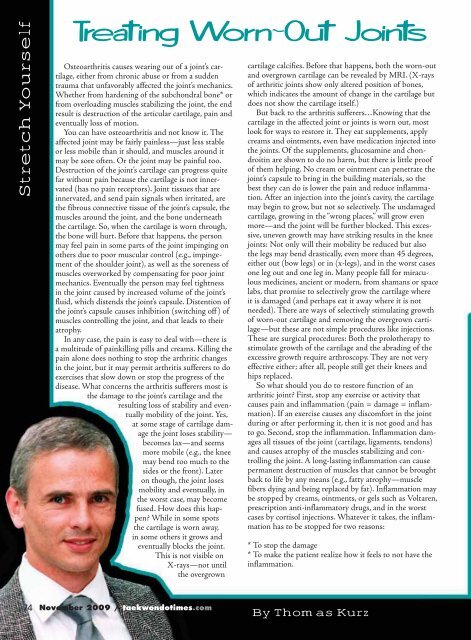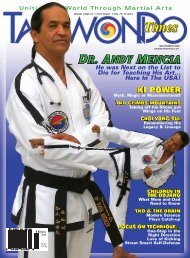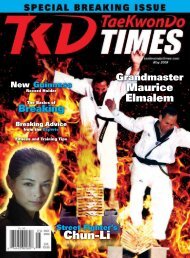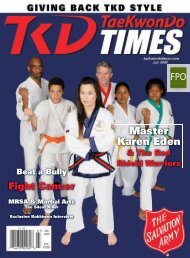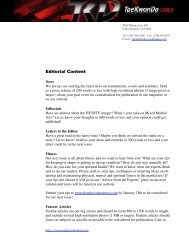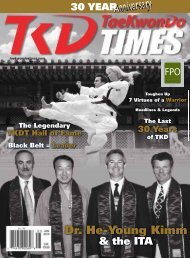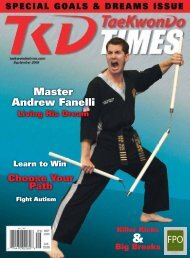Grandmaster Ken MacKenzie - Taekwondo Times
Grandmaster Ken MacKenzie - Taekwondo Times
Grandmaster Ken MacKenzie - Taekwondo Times
You also want an ePaper? Increase the reach of your titles
YUMPU automatically turns print PDFs into web optimized ePapers that Google loves.
Stretch Yourself<br />
<br />
Osteoarthritis causes wearing out of a joint’s cartilage,<br />
either from chronic abuse or from a sudden<br />
trauma that unfavorably affected the joint’s mechanics.<br />
Whether from hardening of the subchondral bone* or<br />
from overloading muscles stabilizing the joint, the end<br />
result is destruction of the articular cartilage, pain and<br />
eventually loss of motion.<br />
You can have osteoarthritis and not know it. The<br />
affected joint may be fairly painless—just less stable<br />
or less mobile than it should, and muscles around it<br />
may be sore often. Or the joint may be painful too.<br />
Destruction of the joint’s cartilage can progress quite<br />
far without pain because the cartilage is not innervated<br />
(has no pain receptors). Joint tissues that are<br />
innervated, and send pain signals when irritated, are<br />
the fibrous connective tissue of the joint’s capsule, the<br />
muscles around the joint, and the bone underneath<br />
the cartilage. So, when the cartilage is worn through,<br />
the bone will hurt. Before that happens, the person<br />
may feel pain in some parts of the joint impinging on<br />
others due to poor muscular control (e.g., impingement<br />
of the shoulder joint), as well as the soreness of<br />
muscles overworked by compensating for poor joint<br />
mechanics. Eventually the person may feel tightness<br />
in the joint caused by increased volume of the joint’s<br />
fluid, which distends the joint’s capsule. Distention of<br />
the joint’s capsule causes inhibition (switching off ) of<br />
muscles controlling the joint, and that leads to their<br />
atrophy.<br />
In any case, the pain is easy to deal with—there is<br />
a multitude of painkilling pills and creams. Killing the<br />
pain alone does nothing to stop the arthritic changes<br />
in the joint, but it may permit arthritis sufferers to do<br />
exercises that slow down or stop the progress of the<br />
disease. What concerns the arthritis sufferers most is<br />
the damage to the joint’s cartilage and the<br />
resulting loss of stability and eventually<br />
mobility of the joint. Yes,<br />
at some stage of cartilage damage<br />
the joint loses stability—<br />
becomes lax—and seems<br />
more mobile (e.g., the knee<br />
may bend too much to the<br />
sides or the front). Later<br />
on though, the joint loses<br />
mobility and eventually, in<br />
the worst case, may become<br />
fused. How does this happen?<br />
While in some spots<br />
the cartilage is worn away,<br />
in some others it grows and<br />
eventually blocks the joint.<br />
This is not visible on<br />
X-rays—not until<br />
the overgrown<br />
cartilage calcifies. Before that happens, both the worn-out<br />
and overgrown cartilage can be revealed by MRI. (X-rays<br />
of arthritic joints show only altered position of bones,<br />
which indicates the amount of change in the cartilage but<br />
does not show the cartilage itself.)<br />
But back to the arthritis sufferers…Knowing that the<br />
cartilage in the affected joint or joints is worn out, most<br />
look for ways to restore it. They eat supplements, apply<br />
creams and ointments, even have medication injected into<br />
the joints. Of the supplements, glucosamine and chondroitin<br />
are shown to do no harm, but there is little proof<br />
of them helping. No cream or ointment can penetrate the<br />
joint’s capsule to bring in the building materials, so the<br />
best they can do is lower the pain and reduce inflammation.<br />
After an injection into the joint’s cavity, the cartilage<br />
may begin to grow, but not so selectively. The undamaged<br />
cartilage, growing in the “wrong places,” will grow even<br />
more—and the joint will be further blocked. This excessive,<br />
uneven growth may have striking results in the knee<br />
joints: Not only will their mobility be reduced but also<br />
the legs may bend drastically, even more than 45 degrees,<br />
either out (bow legs) or in (x-legs), and in the worst cases<br />
one leg out and one leg in. Many people fall for miraculous<br />
medicines, ancient or modern, from shamans or space<br />
labs, that promise to selectively grow the cartilage where<br />
it is damaged (and perhaps eat it away where it is not<br />
needed). There are ways of selectively stimulating growth<br />
of worn-out cartilage and removing the overgrown cartilage—but<br />
these are not simple procedures like injections.<br />
These are surgical procedures: Both the prolotherapy to<br />
stimulate growth of the cartilage and the abrading of the<br />
excessive growth require arthroscopy. They are not very<br />
effective either; after all, people still get their knees and<br />
hips replaced.<br />
So what should you do to restore function of an<br />
arthritic joint? First, stop any exercise or activity that<br />
causes pain and inflammation (pain = damage = inflammation).<br />
If an exercise causes any discomfort in the joint<br />
during or after performing it, then it is not good and has<br />
to go. Second, stop the inflammation. Inflammation damages<br />
all tissues of the joint (cartilage, ligaments, tendons)<br />
and causes atrophy of the muscles stabilizing and controlling<br />
the joint. A long-lasting inflammation can cause<br />
permanent destruction of muscles that cannot be brought<br />
back to life by any means (e.g., fatty atrophy—muscle<br />
fibers dying and being replaced by fat). Inflammation may<br />
be stopped by creams, ointments, or gels such as Voltaren,<br />
prescription anti-inflammatory drugs, and in the worst<br />
cases by cortisol injections. Whatever it takes, the inflammation<br />
has to be stopped for two reasons:<br />
* To stop the damage<br />
* To make the patient realize how it feels to not have the<br />
inflammation.<br />
74 November 2009 / taekwondotimes.com<br />
By Thomas Kurz


